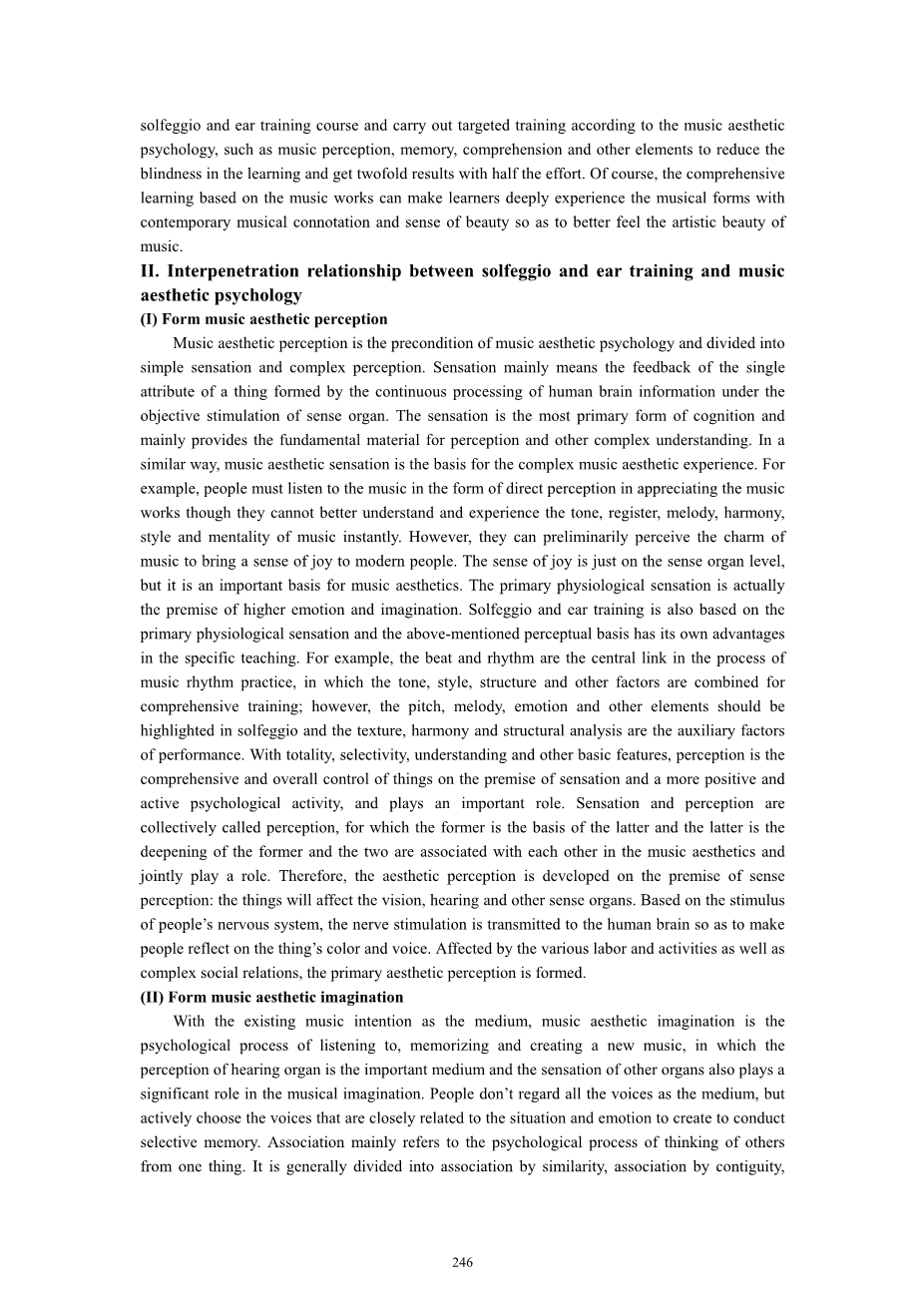视唱练耳与耳的相互渗透研究训练与音乐审美心理美学 外文翻译资料
2023-01-09 11:41:04
Research on Interpenetration Between Solfeggio and Ear
Training and Music Aesthetic Psychology Based on
Aesthetics
原文作者 Dongbo Lin 单位Fujian Vocational College of Art,
关键词:视唱练耳; 音乐审美心理; 相互渗透
在音乐专业教学中,视唱练耳以其科学性、严谨性和逻辑性得到了社会的广泛认可。在教学中,由于教师对这门学科缺乏深入的了解,实践者枯燥乏味的课堂教学很容易使学生在学习中真正形成不好的音乐审美意识,缺乏想象力。因此,有必要深入研究视唱练耳与音乐审美心理之间的相互渗透关系。本文分析了视唱练耳与音乐审美心理研究的必要性,探讨了视唱练耳与音乐审美心理的相互渗透关系hellip;hellip;
外文文献出处:Jason Corey.Technical ear training: Tools and practical methods[J].Proceedings of Meetings on Acoustics,蒙特瑞尔,加拿大:Acoustical Soceity of America,2013.19(025016):1-5.
附外文文献原文
As the society develops continuously, the music works emerge constantly, embodying the diversity of Chinarsquo;s arts. Music, dance and other art works bring profound influences to modern peoplersquo;s life. In any case, peoplersquo;s aesthetics is very important and sensation and acquiring beauty in life can better improve onersquo;s aesthetic ability. The solfeggio and ear training in the classroom teaching of music is closely related to the learnersrsquo; aesthetic consciousness. The learners should comprehensively master the music rhythm, beat, melody and other knowledge and be closely combined with the modern peoplersquo;s life to enjoy the music. The learners can practically and effectively improve their music quality only by sensation the life in the complete music works and echoing with them.
I.Necessity of studying solfeggio and ear training and music aesthetic psychology As solfeggio and ear training is the basic discipline of music, it has aesthetic features. Any music work is the close combination of rhythm, melody, form, style and various musical elements. To have historical style and aesthetics features, the music work must link with the social culture and aesthetic psychology. Solfeggio and ear training is deeply studied in the modern music aesthetic psychology theory, thus laying a theoretical foundation for the solfeggio and ear training education, providing more novel and unique research horizon and opening a new space for further studying music aesthetic psychology. Music aesthetic psychology formed by the cross-edge of many disciplines has rich knowledge content to provide a new perspective and multi-dimensional thinking form for the implementation of solfeggio and ear training. The learners of music can
make an objective and fair evaluation according to the aesthetic features of the teaching of
solfeggio and ear training course and carry out targeted training according to the music aesthetic psychology, such as music perception, memory, comprehension and other elements to reduce the blindness in the learning and get twofold results with half the effort. Of course, the comprehensive learning based on the music works can make learners deeply experience the musical forms with contemporary musical connotation and sense of beauty so as to better feel the artistic beauty of music.
II.Interpenetration relationship between solfeggio and ear training and music aesthetic psychology
(I)Form music aesthetic perception
Music aesthetic perception is the precondition of music aesthetic psychology and divided into simple sensation and complex perception. Sensation mainly means the feedback of the single attribute of a thing formed by the continuous processing of human brain information under the objective stimulation of sense organ. The sensation is the most primary form of cognition and mainly provides the fundamental material for perception and other complex understanding. In a similar way, music aesthetic sensation is the basis for the complex music aesthetic experience. For example, people must listen to the music in the form of direct perception in appreciating the music works though they cannot better understand and experience the tone, register, melody, harmony, style and mentality of music instantly. However, they can preliminarily perceive the charm of music to bring a sense of joy to modern people. The sense of joy is just on the sense organ level, but it is an important basis for music aesthetics. The primary physiological sensation is actually the premise of higher emotion and imagination. Solfeggio and ear training is also based on the primary physiological sensation and the above-mentioned perceptual basis has its own advantages in the specific teaching. For example, the beat and rhythm are the central link in the process of music rhythm practice, in which the tone, style, structure and other factors are combined for comprehensive training; however, the pitch, melody, emotion and other elements should be highlighted in solfeggio and the texture, harmony and structural analysis are the auxiliary factors of performance. With totality, selectivity, understanding and other basic features, perception is the comprehensive and overall control of things on the premise of sensation and a more positive and active psychological activity, and plays an important role. Sensation and perception are collectively called perception, for which the former is the basis of the latter and the latter is the deepening of the former and the two are associated with each other in the music aesthetics and jointly play a role. Therefore, the aesthetic perception is developed on the premise of sense perception: the things will affect the vision, hearing and other sense organs. Based on the stimulus of peoplersquo;s nervous system, the nerve stimulation is transmitted to the human brain so as to make people reflect on the thingrsquo;s color and voice. Affected by the various labor and activities as well as complex social relations, the primary aesthetic perception is formed.
(II)Form music aesthetic imagination
With the existing music intention as the medium, music aesthetic imagination is the psychological process of listening to, memorizing and creating
剩余内容已隐藏,支付完成后下载完整资料


英语原文共 5 页,剩余内容已隐藏,支付完成后下载完整资料
资料编号:[271845],资料为PDF文档或Word文档,PDF文档可免费转换为Word




